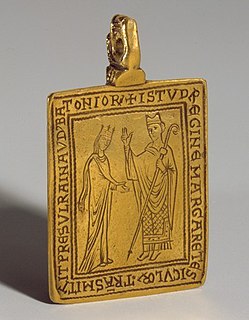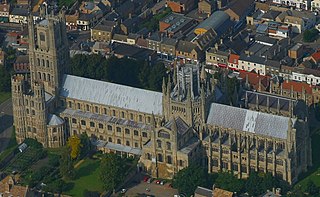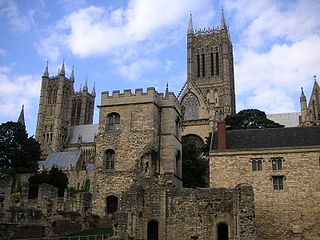Related Research Articles
John de Gray or de Grey was an English prelate who served as Bishop of Norwich, and was elected but unconfirmed Archbishop of Canterbury. He was employed in the service of Prince John even before John became king, for which he was rewarded with a number of ecclesiastical offices, culminating in his pro forma election to Norwich in 1200. De Gray continued in royal service after his elevation to the episcopate, lending the King money and undertaking diplomatic missions on his behalf. In 1205 King John attempted to further reward de Gray with a translation to the archbishopric of Canterbury, but a disputed election process led to de Gray's selection being quashed by Pope Innocent III in 1206.
Geoffrey Ridel was the nineteenth Lord Chancellor of England, from 1162 to 1173.
Eustace was the twenty-third Lord Chancellor of England, from 1197 to 1198. He was also Dean of Salisbury and Bishop of Ely.
Walter Giffard was Lord Chancellor of England and Archbishop of York.
Philip of Poitou was Bishop of Durham from 1197 to 1208, and prior to this Archdeacon of Canterbury.

Reginald fitz Jocelin was a medieval Bishop of Bath and an Archbishop of Canterbury-elect in England. A member of an Anglo-Norman noble family, he was the son of a bishop, and was educated in Italy. He was a household clerk for Thomas Becket, but by 1167 he was serving King Henry II of England. He was also a favourite of King Louis VII of France, who had him appointed abbot of the Abbey of Corbeil. After Reginald angered Becket while attempting to help negotiate a settlement between Becket and the king, Becket called him "that offspring of fornication, that enemy to the peace of the Church, that traitor." When he was elected as a bishop, the election was challenged by King Henry's eldest son, Henry the Young King, and Reginald was forced to go to Rome to be confirmed by Pope Alexander III. He attended the Third Lateran Council in 1179, and spent much of his time administering his diocese. He was elected Archbishop of Canterbury in 1191, but died before he could be installed.

Hervey le Breton was a Breton cleric who became Bishop of Bangor in Wales and later Bishop of Ely in England. Appointed to Bangor by King William II of England, when the Normans were advancing into Wales, Hervey was unable to remain in his diocese when the Welsh began to drive the Normans back from their recent conquests. Hervey's behaviour towards the Welsh seems to have contributed to his expulsion from his see. Although the new king, Henry I wished to translate Hervey to the see of Lisieux in Normandy, it was unsuccessful.
Jocelin of Wells was a medieval Bishop of Bath. He was the brother of Hugh de Wells, who became Bishop of Lincoln. Jocelin became a canon of Wells Cathedral before 1200, and was elected bishop in 1206. During King John of England's dispute with Pope Innocent III, Jocelin at first remained with the king, but after the excommunication of John in late 1209, Jocelin went into exile. He returned to England in 1213, and was mentioned in Magna Carta in 1215.
John of Tours or John de Villula (died 1122) was a medieval Bishop of Wells in England who moved the diocese seat to Bath. He was a native of Tours and was King William I of England's doctor before becoming a bishop. After his consecration as bishop, he was either given or purchased Bath Abbey, a rich monastery, and then moved the headquarters of the diocese from Wells, to the abbey. He rebuilt the church at Bath, building a large cathedral that no longer survives. He gave a large library to his cathedral and received the right to hold a fair in Bath. Not noted for his scholarship, he died suddenly in 1122.
William of Bitton was a medieval English Bishop of Bath and Wells.
William of Bitton was a medieval Bishop of Bath and Wells.
Robert de Chauncy was a medieval Bishop of Carlisle.
Simon of Wells was a medieval Bishop of Chichester.
Hugh Foliot was a medieval Bishop of Hereford. Related somehow to his predecessor at Hereford, he served as a priest and papal judge as well as being an unsuccessful candidate as Bishop of St David's in Wales. In 1219, he was appointed Bishop of Hereford. During his time in office, he mostly attended to ecclesiastical duties, but did occasionally serve as a royal administrator. He helped found a hospital and a priory, and died in 1234 after a months-long illness.
William de Blois was a medieval Bishop of Lincoln. He first served in the household of Hugh du Puiset, the Bishop of Durham, then later served the household of Hugh of Avalon, Bishop of Lincoln. After Hugh's death and a two-year vacancy in the see, or bishopric, Blois was elected to succeed Hugh in 1203. Little is known about his episcopate, although 86 of his documents survive from that time period. He died in 1206 and was buried in his cathedral.

Hugh of Wells was a medieval Bishop of Lincoln. He began his career in the diocese of Bath, where he served two successive bishops, before joining royal service under King John of England. He served in the royal administration until 1209, when he was elected to the see, or bishopric, of Lincoln. When John was excommunicated by Pope Innocent III in November 1209, Hugh went into exile in France, where he remained until 1213.

Richard Marsh, also called Richard de Marisco, served as Lord Chancellor of England and Bishop of Durham.

William of Wrotham or William de Wrotham was a medieval English royal administrator and clergyman. Although a late 13th-century source says that William held a royal office under King Henry II of England, the first contemporary reference to William is in 1197, when he became responsible for, among other things, the royal tin mines. He also held ecclesiastical office, eventually becoming Archdeacon of Taunton, and served King John of England as an administrator of ecclesiastical lands and a collector of taxes.
Burchard du Puiset was a medieval Anglo-Norman clergyman and treasurer of the diocese of York. Either the nephew or son of Hugh du Puiset, the Bishop of Durham, Burchard held a number of offices in the dioceses of York and Durham before being appointed treasurer by King Richard I of England in 1189. His appointment was opposed by the newly appointed Archbishop Geoffrey, which led to a long dispute between Geoffrey and Burchard that was not resolved until the mid 1190s. After the death of Hugh du Puiset, Burchard was a candidate for the Hugh's old bishopric, but lost out in the end to another candidate. Burchard died in 1196.
Hamo was a 12th- and 13th-century English cleric. He was the Diocese of York's dean, treasurer, and precentor, as well as the archdeacon of the East Riding. His background is unknown, but he was probably a canon of the cathedral chapter at York Minster by 1171. He claimed to have been treasurer of the chapter by 1189, but did not actually hold the office until 1199. Hamo clashed with his archbishop, Geoffrey several times, and when Geoffrey died, Hamo's fellow canons were forbidden by King John of England from electing Hamo to succeed Geoffrey. Hamo died sometime after 1219, when he was last attested as holding his final office, dean.
References
- Fryde, E. B.; Greenway, D. E.; Porter, S.; Roy, I. (1996). Handbook of British Chronology (Third revised ed.). Cambridge, UK: Cambridge University Press. ISBN 0-521-56350-X.
- Gillingham, John (1999). Richard I. New Haven, CT: Yale University Press. ISBN 0-300-07912-5.
- Greenway, Diana E. (1971). "Archdeacons: Canterbury". Fasti Ecclesiae Anglicanae 1066–1300. Vol. 2: Monastic Cathedrals (Northern and Southern Provinces). Institute of Historical Research. Retrieved 14 March 2009.
- Greenway, Diana E. (1977). "Archdeacons of Northampton". Fasti Ecclesiae Anglicanae 1066–1300. Vol. 3: Lincoln. Institute of Historical Research. Retrieved 23 September 2007.
- Greenway, Diana E. (1991). "Treasurers". Fasti Ecclesiae Anglicanae 1066–1300. Vol. 4: Salisbury. Institute of Historical Research. Retrieved 23 September 2007.
- Greenway, Diana E. (2001). "Bishops". Fasti Ecclesiae Anglicanae 1066–1300. Vol. 7: Bath and Wells. Institute for Historical Research. Retrieved 23 September 2007.
- Knowles, David; London, Vera C. M.; Brooke, Christopher (2001). The Heads of Religious Houses, England and Wales, 940–1216 (Second ed.). Cambridge, UK: Cambridge University Press. ISBN 0-521-80452-3.
- Knowles, David (1976). The Monastic Order in England: A History of its Development from the Times of St. Dunstan to the Fourth Lateran Council, 940–1216 (Second reprint ed.). Cambridge, UK: Cambridge University Press. ISBN 0-521-05479-6.
- Ramsey, Frances (2004). "Savaric (d. 1205)". Oxford Dictionary of National Biography. Oxford University Press. doi:10.1093/ref:odnb/24732 . Retrieved 15 November 2007.(subscription or UK public library membership required)
- Spear, David S. (2006). The Personnel of the Norman Cathedrals during the Ducal Period, 911–1204. Fasti Ecclesiae Anglicanae. London: Institute of Historical Research. ISBN 1-871348-95-1.
- Thompson, Kathleen (2002). "Queen Adeliza and the Lotharingian Connection". Sussex Archaeological Collections. 40: 57–64. doi: 10.5284/1085796 .
- Vincent, Nicholas (2002). Peter des Roches: An Alien in English Politics 1205–1238 (Reprint ed.). Cambridge, UK: Cambridge University Press. ISBN 0-521-52215-3.